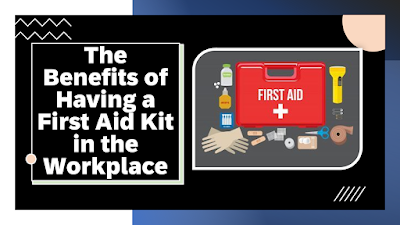The Benefits of Having a First Aid Kit
in the Workplace
The Benefits of Having a First Aid Kit in the Workplace
For any workplace safety
plan the first aid kits are an essential component. The first aid kits to be
handled by the trained certified first aiders and these first aiders should be
available in each shift, or the paramedics should be available in all shifts of
the company operation. Incidents and injuries can happen at any time and having
a well-stocked first aid kit in the workplace can help prevent minor injuries
from turning into major emergencies. In this article, we will explore the
benefits of having a first aid kit in the workplace and why it's important to
keep it fully stocked.
Benefits of Having a First Aid Kit in the Workplace
Minimizes the Risk of Infection
A first aid kit in the workplace can help reduce the risk of infection by allowing employees to treat wounds immediately by the certified first aiders or by the paramedics. Ensure that the first aid supports are recorded in the OHC – Occupational Health Centre. By keeping the wound clean and bandaged, the risk of infection is greatly reduced. This can help prevent the spread of harmful bacteria and viruses that could potentially cause illness or disease.
Quick Response to Emergencies
Quick response is one
of key to any emergencies. When an incident occurs, time is of the essence.
Having a first aid kit in the workplace can help employees respond quickly to
emergencies and provide immediate care until medical professionals arrive. This
can help minimize the severity of the injury and improve the chances of a
successful recovery.
Compliance with Health and Safety Regulations
All the industries are required by law or local government regulations to have a first aid kit in the workplace. By complying with health and safety regulations, employers can avoid fines and penalties while ensuring that their employees are safe and protected. The number of certified first aiders also a requirement in some countries for the industry workplace.
Boosts Employee Morale
When employees feel
that their safety is a priority, it can boost morale and increase job
satisfaction. Knowing that their employer has taken steps to ensure their
safety can create a positive work environment and promote a sense of loyalty
among employees. The training on first aid techniques will also boost the
employees morale and this training will help the employees to use for the
medical emergencies in their home or society.
Reduces Liability Risks
If an employee is injured on the job and the employer does not have a first aid kit available, the employer could be held liable for any damages. By having a first aid kit in the workplace, employers can reduce their liability risks and protect themselves from potential lawsuits.
What Should Be Included in a Workplace First Aid Kit?
A well-stocked first
aid kit should contain some of the following items:
(Follow as per the local regulations)
Bandages in various sizes and shapes
Gauze pads and adhesive tape
Disposable gloves
Scissors and tweezers
Antiseptic wipes and ointments
Cold compresses
Pain relievers
CPR mask etc
Steam Hazards and Safety Requirements
Emergency phone numbers
It's important to ensure that the first aid kit is easily accessible to all employees and that everyone knows where it is located. Regularly checking and restocking the first aid kit is also crucial to ensure that it is always fully stocked and ready to use. The certified first aiders name & contact numbers to be displayed in the prominent location and all employees should be aware of it.
When it comes to workplace safety, having a first aid kit is just one part of a larger safety plan. Employers should also provide training to their employees on how to respond to emergencies and properly use the items in the first aid kit. This can include basic CPR and first aid training, as well as education on how to identify and report workplace hazards.
Employers should also
conduct regular safety audits to identify potential hazards and address them
before they lead to an accident or injury. This can include ensuring that
equipment is properly maintained and that there are no tripping or slipping
hazards in the workplace.
Additionally, employers should have an emergency response plan in place for more serious incidents, such as fires or natural disasters. This plan should include evacuation procedures and designated meeting places for employees to gather after an emergency.
In terms of first aid kit maintenance, employers should designate a responsible person to check and restock the kit on a regular basis. This can be done monthly or quarterly, depending on the size and type of workplace. It's also important to replace expired items and ensure that the kit is in good condition.
Having a first aid kit in the workplace is not only a legal requirement in many industries, but it's also a common-sense measure to protect employees and promote a safe and healthy work environment. By ensuring that the first aid kit is well-stocked, easily accessible, and properly maintained, employers can help prevent minor injuries from turning into major emergencies, and reduce the risk of liability in the event of an accident.
H2S Hydrogen Sulfide Gas Safety
Conclusion
In conclusion, having a
first aid kit in the workplace is essential for ensuring the safety and
well-being of employees. It can help reduce the risk of infection, allow for a
quick response to emergencies, ensure compliance with health and safety
regulations, boost employee morale, and reduce liability risks. Employers
should ensure that their first aid kit is well-stocked with all the necessary
items and easily accessible to all employees. By doing so, they can create a
safer and healthier work environment for everyone.

No comments:
Post a Comment